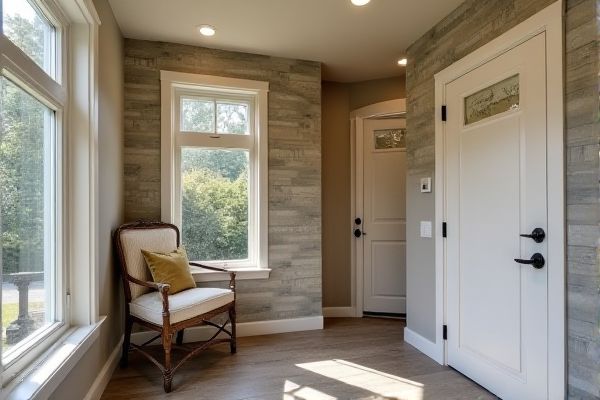
Choosing between mudroom stone veneer and natural stone involves weighing factors like cost, installation ease, and aesthetic appeal; stone veneer offers a lightweight, budget-friendly option that mimics natural stone's texture without the extra weight. Explore the rest of the article to discover which option best suits Your mudroom design and maintenance needs.
Table of Comparison
| Feature | Mudroom Stone Veneer | Natural Stone |
|---|---|---|
| Material Composition | Manufactured stone made from concrete and aggregates | Quarried natural rock such as granite, limestone, or slate |
| Appearance | Consistent texture and color, mimics natural stone | Unique, varied texture and color with natural imperfections |
| Weight | Lightweight, easier to handle and install | Heavy, requires strong structural support |
| Installation | Faster, can be installed by DIY enthusiasts | Labor-intensive, requires skilled masonry work |
| Durability | Good for indoor mudrooms, moderately resistant to wear | Highly durable and long-lasting, withstands moisture and impact |
| Cost | More affordable, lower material and labor costs | Higher cost due to material and skilled labor requirements |
| Maintenance | Low maintenance, easy to clean | Requires periodic sealing and cleaning to preserve appearance |
| Environmental Impact | Manufactured, can have higher carbon footprint depending on production | Natural product, but quarrying impacts environment |
| Lifespan | 10-20 years with proper care | 50+ years or more with proper maintenance |
Introduction: Mudroom Stone Veneer vs. Natural Stone
Mudroom stone veneer offers a lightweight, cost-effective alternative to natural stone, making installation faster and less labor-intensive while still providing an attractive, durable surface. Natural stone boasts unmatched authenticity, longevity, and unique textures that enhance the aesthetic value of your mudroom but requires more maintenance and structural support. Choosing between stone veneer and natural stone depends on your budget, design preferences, and the desired balance between practicality and natural beauty.
What Is Stone Veneer?
Stone veneer is a lightweight, manufactured material designed to replicate the appearance of natural stone while being easier to install and more cost-effective for your mudroom walls. Unlike natural stone, which is quarried and cut into thick slabs, stone veneer consists of thin slices of stone or synthetic materials bonded to a backing for simple application on interior or exterior surfaces. This makes stone veneer an ideal choice when you want the aesthetic of real stone without the weight and expense of natural stone installations.
Understanding Natural Stone for Mudrooms
Natural stone for mudrooms offers unparalleled durability and unique texture, enhancing both aesthetic appeal and functional resilience. Its intrinsic properties, like varying hardness and porosity, provide natural resistance to wear, stains, and moisture commonly encountered in high-traffic entry areas. Selecting natural stone requires consideration of species such as slate, granite, or limestone to align with desired maintenance levels and visual style.
Aesthetic Comparison: Veneer vs. Natural Stone
Mudroom stone veneer offers a consistent, uniform appearance with a wide range of colors and textures, making it ideal for achieving a specific design aesthetic. Natural stone, however, provides unique variations and organic patterns that add depth and character, creating a more authentic and timeless look. While veneer is lightweight and easier to install, natural stone's tactile richness enhances the overall visual impact and durability in a mudroom setting.
Durability and Longevity in Mudroom Settings
Mudroom stone veneer offers excellent durability with a lightweight profile resistant to chipping and cracking, making it ideal for high-traffic, moisture-prone areas. Natural stone provides unmatched longevity and strength, often lasting decades with proper sealing to prevent water damage and staining. While natural stone demands more maintenance, its robustness and timeless appeal make it a superior choice for enduring mudroom environments.
Installation Process: Stone Veneer vs. Natural Stone
Stone veneer installation involves lighter materials that are easier to cut and attach directly to existing walls, reducing labor and structural support requirements compared to natural stone. Natural stone installation demands skilled masons, mortar application, and often reinforced foundations due to its heavier weight and thickness. Choosing stone veneer for your mudroom streamlines the process, minimizing installation time and potentially lowering costs while still providing an authentic stone appearance.
Cost Analysis: Initial and Long-Term Expenses
Mudroom stone veneer offers a cost-effective alternative to natural stone, with significantly lower initial expenses typically ranging from $6 to $12 per square foot compared to natural stone's $15 to $30 per square foot. Long-term, stone veneer tends to require less maintenance and is less prone to cracking or weathering, reducing repair costs over time. Your choice should consider both upfront budget and potential future expenses to ensure the best investment for your mudroom's durability and aesthetic.
Maintenance Requirements for Both Materials
Stone veneer in your mudroom offers lower maintenance requirements compared to natural stone, as it resists moisture absorption and staining more effectively. Natural stone demands regular sealing and cleaning to prevent damage from dirt, water, and wear, making upkeep more intensive. Choosing stone veneer reduces your routine maintenance efforts while still providing a durable and stylish finish.
Environmental Impact and Sustainability Factors
Mudroom stone veneer offers a more sustainable option compared to natural stone by reducing quarrying impact, energy consumption, and transportation emissions due to its lightweight and manufactured composition. Natural stone has a higher carbon footprint because it requires extensive extraction, heavy machinery use, and longer shipping distances, which contribute to habitat disruption and resource depletion. Your choice of stone veneer supports eco-friendly construction by utilizing recycled materials and promoting efficient production processes that lower overall environmental impact.
Choosing the Best Option for Your Mudroom
Mudroom stone veneer offers lightweight, cost-effective, and easy-to-install benefits, making it ideal for quick renovations and budget-conscious projects. Natural stone provides unmatched durability, authentic texture, and long-term value, suitable for high-traffic areas exposed to moisture and wear. Consider your mudroom's usage, budget, and desired aesthetic to determine which option best enhances your space's functionality and appearance.
 homyna.com
homyna.com